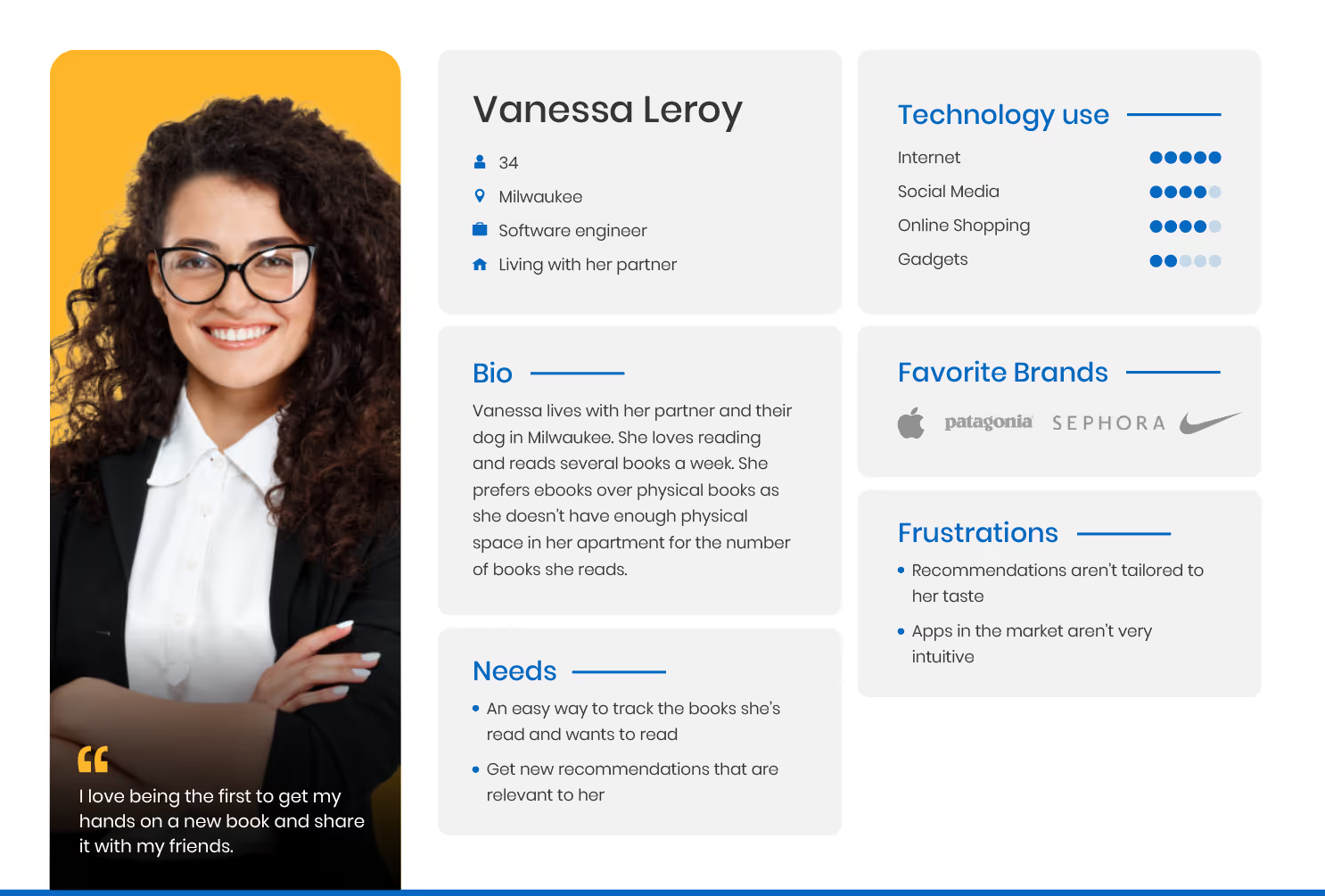Imagine it's 2005 — the era before online navigation. You’re travelling to a completely new location, the route shared over a quick phone call, some more semi-accurate data gotten from passersby, but overall fairly lost. Best case — you make it to your destination after a number of painful detours. That’s what it’s like to design products without a crystal-clear idea of your user personas. User personas provide the direction and the tools for mapping out your customer experience. Good design requires deep knowledge of the user. UX designers need to get to know users in their own context, clearly understanding their objectives, needs, challenges, motivations, and behaviors. While it’s not easy to design towards a particular set of data points, it’s much easier to understand requirements when they’re expressed in reference to a person. We all have empathy and can instinctively relate to other people and their challenges. Personas are built using real data to create model or composite characters. These become the archetypes that can be used to gauge progress at each stage of design. These are the ideal users of a product or service. By asking how a persona would respond to a particular feature or aspect of the design, what their needs are, or what they might struggle with, designers can quickly arrive at the most optimal path to follow.
How to create a user persona
A persona is generally a 1-2 page document that outlines key details about a particular type of user. It includes some background information on the persona as well as details about their behavior, skills, goals, and beliefs. It could also describe the context within which the persona operates. Although personas are created using real data collected from real users, they can include a few fictional details to make the characters realistic and believable, such as names, photos, and quotes. Typical information explored in a persona includes:
- Name (fictional)
- Demographic data such as age, gender, location, and family status
- Their major goals, pain points, and motivations
- A short bio
- Significant personality traits or attitudes
- Photographs that evoke the user’s environment
- Technology usage or channel preferences
- A quote that highlights the persona’s biggest concerns (fictional)
Certain kinds of design projects may require the inclusion of more context-specific information, such as their usage of particular tools, their spending patterns, and other details that may be relevant.

CAPTION: Example user persona for a mobile app that provides book recommendationsIf you’re unsure of how to create user personas, here are some templates from Miro and Xtensio you can try filling in to help you get started.
Why user personas are important
Personas make it possible to condense user research into easily consumable chunks of information. In this way, they make the design problem clearly visible and understandable. With less complexity and ambiguity in understanding the data, designers acquire a precise understanding of the user and can design towards the right goals. Let’s look at some of the advantages that personas offer.
Personas allow designers to build better products
Personas are more than a stereotype or a flat representation of a user. They provide a way to synthesize and communicate information in an easy-to-consume format. Personas are also memorable, making it easy for designers to prioritize important information. They allow designers to keep the user’s perspective in mind in a way that other user research methods simply cannot do. With personas, designers can easily visualize the user context and refer back to key insights. In this way, designers can ideate within the right set of constraints, prioritize the right features, evaluate features accurately, and make more informed decisions. With a clear understanding of the user, all elements of the design can be customized to meet user needs. Personas provide a way for designers to anticipate users’ challenges and needs and build products that speak to users’ values and beliefs. By deeply understanding the user’s needs, behaviors and goals, designers can create better solutions to user problems. Read 25 Critical Questions to Ask When Starting a UX Project
Personas help designers steer clear of bias and errors
It’s only human to assume everyone thinks like us and would behave the same way. But good design requires empathy, which is gained from observing people within their own environment and understanding their frustrations. Creating user personas provides an opportunity for designers to step out of their own context and assumptions and become attuned to the users’ needs instead. Creating this separation between themselves and the user allows them to become aware of their personal biases, as well as recognize how the user might perceive or interact with the product differently. This leads to better, more focused design. Read A Beginner’s Guide to User Research
Personas create alignment among designers and stakeholders

Product teams are made up of many stakeholders who need to collaborate with each other. This can sometimes result in conflict and indecision. Personas help create alignment. With a single consistent, specific understanding of who the user is and what’s important to them, everyone is on the same page and there’s no room for misinterpretation. Since every design decision has to be made keeping the user in mind, potential disagreements can be avoided or resolved faster using personas. Consensus-building becomes easier. Simply asking how the persona would respond to a particular feature or service offering can help provide the necessary perspective. Read What are Mood Boards and How Are They Important in the UX Design World?
Personas boost value delivered across the design workflow
By using personas, designers gain a holistic understanding of their users. This understanding then informs everything from buyer journeys to brand strategies. Personas can be used to answer questions about user experience at every stage and identify new opportunities to serve users’ needs. With personas, design efforts are more focused, conversations more productive, and decisions more effective across functions such as copywriting, information architecture, design, development, and promotion. This helps to improve efficiency and saves time and resources. It also prevents rework, increasing the project’s return on investment. Read 6 Key Steps to Performing a UX Audit
Personas help clarify product positioning

Creating products that are closely targeted towards a particular user group from the start ensures that the product is highly useful and relevant to them. A well-designed product will evoke strong positive feelings in users. This means that when the time comes to promote the product, brands are able to easily create a strong positioning within the product’s category and niche. It also helps reduce time to market as marketers already have the groundwork laid out for them. Tailored marketing campaigns can easily be created that speak to specific audience groups with branding and messaging that resonates. In addition, familiarity with user behavior means brands already know where users spend their time, and they can target them on the right channels.
Start with user personas for better design outcomes
User personas are not only essential to the design process — they are the foundation of good design. Knowing how to create a user persona is critical for UX design success. Personas help designers understand their users better and develop empathy with them. This gives them the perspective they need to make decisions that address users’ frustrations and help them achieve the outcomes they want. Instead of building products for a universal or general use case, designers can then create products that are tailor-made for their specific users and contexts. By defining user personas at the beginning of the design process, UX designers can build better products that engage and convert, achieving long-term success. Read How to Create the Best Color Palette for Your Product’s UI
.avif)










.jpg)









